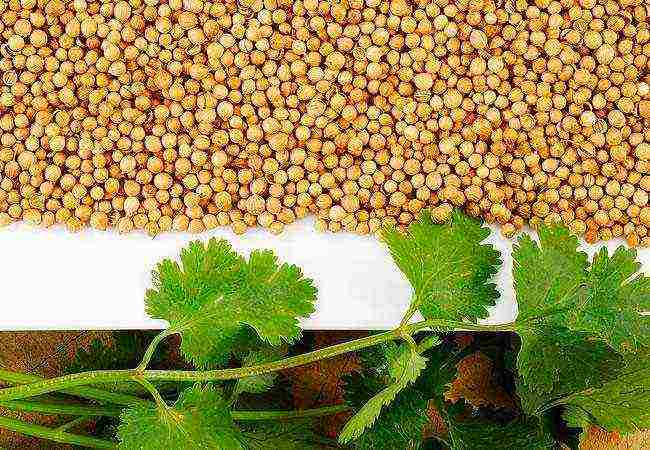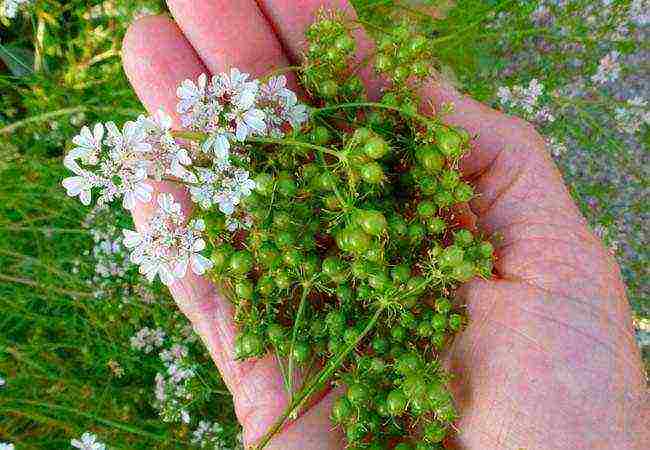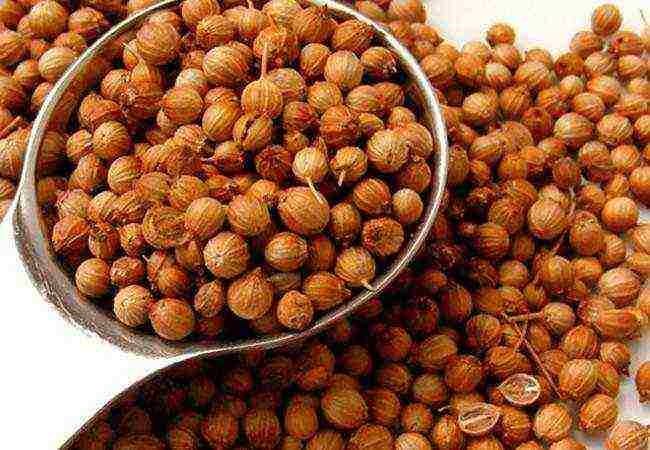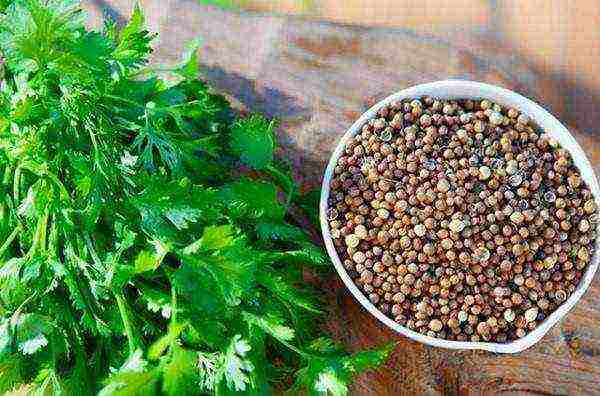Content
Greens have long become an integral part of human life, especially in cooking: they are added to salads and various dishes from vegetables and meat.
For example, coriander seed, or cilantro, is found in many culinary recipes, where it acts as a spice that enhances the taste of dishes. Let's dwell on the most popular varieties of this spicy plant and find out how it looks and in what conditions it grows.
Coriander: description and history of appearance in Russia
Sowing coriander - Coriandrum sativum L
An annual herb from the Umbelliferae family, reaching 70 cm in height. It has a fusiform root and straight rounded stems, branched from the base, with pinnately dissected leaves.
It blooms in May-July with small pinkish or white flowers, collected in complex umbrellas. Coriander fruits, ripening in July-August in the form of brown achenes up to 0.5 cm long, have a strong odor.
In the wild, coriander grows in the south of the European part of Russia, the Caucasus, Central Asia and the Crimea. Coriander is massively grown in the North Caucasus, Ukraine, and the European part of Russia. The most desperate gardeners manage to grow cilantro even in the central regions of Yakutia!
Historical roots of cilantro
Coriander came to our country not so long ago - at first it settled in other countries:
- In the countries of Western and Central Europe, coriander appeared thanks to the Romans. In particular, it was brought to England in the 1st century AD. BC, where it was grown for a long time in the southeastern counties (now it grows there as a wild plant).
- Cilantro was brought to New Zealand, America and Australia by Europeans at the time of geographical discoveries in the 15th-17th centuries.
- In Russia, coriander seed began to be grown only in the 30s of the 19th century, although it first appeared in our country in the 18th century. Together with anise, cilantro in the form of seeds was brought from Spain by Count P.I. Apraksin. He distributed anise seeds to the peasants of the village of Krasnoye, Voronezh province, so that they could start growing a new spice. Among the aniseed seeds were coriander seeds. They were ordered to weed out like weeds, but cilantro turned out to be tenacious. Over time, it was tasted and recognized as a herb.
Cilantro photo
We attach a few photos of coriander (greens and seeds) for your reference in order to understand what coriander and cilantro look like in reality.
 Photo of a plant coriander or cilantro
Photo of a plant coriander or cilantro How to use cilantro
How to use cilantro
Fields of application of coriander seed or cilantro
Application in various spheres of human life is found as greens and cilantro seeds, and its essential oil. Here are some ways to use this spice:
- Essential oil of cilantro serves as a raw material for the synthesis of aromatic substances that make up cosmetics and perfumery.
- The fatty oil of coriander, which remains after the distillation of the essential oil, is widely used in the printing, textile and soap industries.
- Coriander is added to a variety of foods: breads, sauces, pastries, cold meats, cheeses, beer, and liqueurs. It enriches the taste of homemade dishes, so it is served with meat dishes in the form of herbs rich in vitamins A and C.
- Cilantro seeds help heal wounds, relieve pain, improve digestion and liver function, eliminate constipation, and heal hemorrhoids, so they are used for medicinal purposes. Cilantro in veterinary medicine is used to remove worms in animals.
- Nutritious coriander meal is used as feed for poultry, rabbits and livestock.
Types of cilantro
Any varieties of cilantro contain a lot of carotene, vitamins A, C, B1 and B2, and their seeds contain sugar, starch and the most useful essential oil. Let's take a look at the best varieties of coriander.
- Coriander Amber and CARIBE F1... Essential oil-bearing spicy varieties with abundant green mass, late shooting and a pronounced aroma. The cultivars are rich in essential oils, so the seeds and leaves give off a strong aroma.
The leaves are tender and tasty, well suited for first and second courses, salads. The seeds can be added to sausages, baked goods, and marinades.
Variety "Yantar" and "CARIBE F1" are sown on fertile light soils until mid-summer at intervals of two to three weeks. Seedlings appear on the 12-15th day. When the plants reach 10-15 cm in height, we can cut them for greenery. If seeds are needed, we collect them when they are 40% brown.
- Coriander Debut... A variety that ripens in a month and a half from germination. Grown in the open field as a spice and as a variety of cilantro for herbs. Forms a semi-spreading raised rosette of leaves with abundant green mass, reaching 29 cm in height and 25 g in weight.
Leaves and petioles are green. They are appreciated for their pleasant delicate taste and strong spicy aroma. Since they contain a large amount of vitamins P and E, they are put in meat and fish dishes, fresh salads. And the most fragrant seeds enrich the taste of sausages, sauces, bread, pastries and marinades.
Seeds of the Debut variety are sown in the ground in April. To keep fresh cilantro on the table for a long time, we regularly sow it every 2-3 weeks.
 Types and varieties of cilantro
Types and varieties of cilantro
- Vegetable Coriander Stimulus... Mid-season variety with a neat rosette of abundant glossy leaves. One outlet can weigh 45g.
It is best to sow it after table roots, potatoes and legumes that have been fertilized with organic matter. We sow the variety in April, repeated every 2-3 weeks until mid-summer, so that there is fresh greens every day. If seeds are needed, we sow coriander in early spring with a thirty-centimeter distance between rows.
- Coriander Borodinsky. A spicy variety with juicy aromatic leaves that can be cut 35-45 days after germination. The fruits are harvested after three months.
Fresh cilantro leaves are good in salads, meat and fish dishes. The seeds are used as a spice in pure form or as a mixture with other herbs.
- Taiga coriander. A late-ripening spicy annual: can be cut for greens 35-45 days after germination. The variety is distinguished by a very bright color, dense foliage and a strong distinctive aroma. The leaves of young plants are used in cooking various dishes, the seeds are used as a seasoning.
- Coriander venus... A late ripening variety with a half-raised rosette of delicious leaves emitting a delicate aroma. Like other varieties of cilantro, it is used in cooking as herbs and seeds.
- Coriander Vanguard... A low, highly aromatic cultivar with a medium-sized raised rosette of leaves and white flowers. Delicate leaves and young stems are good in salads. Ripe seeds and dried leaves make a great spicy seasoning for meals. The variety is mid-season, so the first cut for greens can be done after 45 days.
These are not all varieties of cilantro - new ones appear regularly, with improved taste and aroma qualities. But, whatever the variety of sowing coriander, they are all endowed with a lot of health benefits.
 Cilantro belongs to the annual spicy-flavoring vegetable crops. It has a specific aroma that not everyone likes, however, in Caucasian cuisine, the herb is very popular and is added to most vegetable, fish and meat dishes.
Cilantro belongs to the annual spicy-flavoring vegetable crops. It has a specific aroma that not everyone likes, however, in Caucasian cuisine, the herb is very popular and is added to most vegetable, fish and meat dishes.
Spicy grass can also be found under other names, such as coriander, bedbug, kismets.
Cilantro blooms in the second half of summer until the end of August and is a good honey plant, attracting bees to the garden. When growing cilantro, it should be borne in mind that it needs long-term lighting, and on average 45 days pass from planting to harvest.In addition, with insufficient moisture, coriander quickly releases flower stalks.
The name of the plant comes from the Greek word "kores", which means "bug". Perhaps cilantro got it because of a special, not very pleasant smell that unripe fruits and the green part of the plant emit.
Growing features
Since cilantro seeds have the ability to germinate even at low temperatures (from 6 degrees Celsius), you can start sowing spices in open ground in early spring. Often, gardeners practice planting in several waves, spaced by two weeks between them. Sowing can be carried out until the end of August.
Rather large cilantro seeds are sown in wide rows with a distance of about 40 cm between them. The seeding depth is 2-3 cm.
Young seedlings are very frost-resistant and easily tolerate recurrent spring frosts, even up to 7 degrees below zero. However, for the active growth of valuable green mass of cilantro, more comfortable conditions are required - at least 22 degrees Celsius.
Coriander also needs the sun, so shady areas for planting it are not suitable - there the bushes will stretch out and do not form lush foliage. No less important is abundant watering, the maximum need for which in cilantro occurs during the flowering period.
The soil for cultivation must be fertile. It is good to plant the spice after legumes, cucumbers, potatoes or cabbage.
Favorite varieties of gardeners
Most often, the following types of coriander are grown on the plots:
- Venus... Differs in early ripening, used in salads. The height of the bush is up to 80 cm.
- Picnic... Early maturing low bushes no more than 40 cm in height with a lot of large leaves. Ripens after 35 days. Differs in high productivity - from 1 sq. m. of the area you can collect 3 kg of greenery.
- Borodinsky... Mid-season variety, ready for consumption 45 days after planting. The height of the bushes is up to 70 cm, the yield is high.
We grow a healthy spice cilantro - video
Coriander Variety: Vanguard
Included in the State Register of the Russian Federation for growing in private household plots. Recommended for use as salad greens (leaves, young stems) and spices (dried leaves, ripe seeds). Mid-season. Period from ...
Coriander variety: Accord
Included in the State Register of the Russian Federation for the zones of cultivation of culture. Recommended for use on seeds. Seeds are globular, light brown. There is no root outlet. The leaf is green, the dissection is medium. There is no anthocyanin coloration of the umbrella. Flower…
Coriander variety: Alekseevsky 190
Bred by individual selection from the population 2502. Included in the State Register for the Russian Federation. Shoots are green. The bush is semi-closed, 56-102 cm high. The stem is straight, branched, 3.5-6.5 cm thick. The height of attachment of the lower branches ...
Coriander variety: Alekseevsky 413
It is included in the State Register of the Russian Federation for the zones of cultivation of crops for the production of essential oil and the use of fruits in the food industry. The plant is erect, of medium height, strongly branched. There is no root outlet. Strongly dissected leaf….
Coriander variety: Armenian
Included in the State Register of the Russian Federation for growing in private household plots. Recommended for use as salad greens (leaves, young stems) and spices (dried leaves, ripe seeds). Mid-season. Period from ...
Coriander variety: Borodinsky
Included in the State Register for the Russian Federation for garden plots, household and small farms. Recommended for use as salad greens (leaves, young stems) and spices (dried leaves, ripe ...
Coriander variety: Oriental flavor
Included in the State Register of the Russian Federation for growing in private household plots. Recommended for use as salad greens (leaves, young stems) and spices (dried leaves, ripe seeds).Mid-season. Period from ...
Coriander variety: Debut
Included in the State Register of the Russian Federation for growing in private household plots. Recommended for use as salad greens (leaves, young stems) and spices (dried leaves, ripe seeds). Mid-season. Period from ...
Coriander variety: Caribe
Included in the State Register of the Russian Federation for growing in private household plots. Recommended for use as salad greens (leaves, young stems) and spices (dried leaves, ripe seeds). Late maturing. Period from ...
Coriander variety: Kin-dza-dza
Included in the State Register of the Russian Federation for growing in private household plots. Recommended for use as salad greens (leaves, young stems) and spices (dried leaves, ripe seeds). Mid-season. Period from ...
Coriander variety: King of the market
Included in the State Register of the Russian Federation for growing in private household plots. Recommended for use as salad greens (leaves, young stems) and spices (dried leaves, ripe seeds). Mid-season. Period from ...
Coriander variety: Krylatsky semko
Included in the State Register for the Russian Federation for garden plots, household and small farms. Recommended for fresh use and as a spice for various dishes in home cooking….
Coriander variety: Marino
Included in the State Register of the Russian Federation for growing in private household plots. Recommended for use as salad greens (leaves, young stems) and spices (dried leaves, ripe seeds). Mid-season. Period from ...
Coriander variety: Firstborn
Included in the State Register for the Russian Federation for garden plots, household and small farms. Recommended for use as salad greens (leaves, young stems) and as a spice seasoning (leaves, ripe ...
Coriander Variety: Picnic
Included in the State Register for the Russian Federation for garden plots, household and small farms. Recommended for use as salad greens (leaves, young stems) and spices (dried leaves, ripe ...
Coriander variety: Delight
Included in the State Register for the Russian Federation for garden plots, household and small farms. Recommended for use as salad greens (leaves, young stems) and spices (dried leaves, ripe ...
Coriander variety: Santo
Included in the State Register of the Russian Federation for growing in private household plots. Recommended for use as salad greens (leaves, young stems) and spices (dried leaves, ripe seeds). Mid-season. Period from ...
Coriander variety: Light
Derived by individual selection from sample 3687. Included in the State Register for the Russian Federation. Seedlings are light green. Loose bush. The diameter of the plant is 25-30 cm. The stem is 0.7-1.0 cm thick, without pubescence, with a weak anthocyanin ...
Coriander variety: Stimulus
Included in the State Register for the Russian Federation. The rosette of the plant is compact, erect, densely leafy, 25-30 cm high. Leaves per rosette 12-27 pcs. The leaf is bipinnate, dark green, glossy. The notch of the edge of the sheet is deep. The petiole is green, sometimes ...
Coriander variety: Taiga
Included in the State Register for the Russian Federation for garden plots, household and small farms. Recommended for use as salad greens (leaves, young stems) and spices (dried leaves, ripe ...
Coriander variety: Chicot
Included in the State Register for the Russian Federation for garden plots, household and small farms. Recommended for use as salad greens (leaves, young stems) and spices (dried leaves, ripe ...
Coriander variety: Eva
Derived by the method of chemical mutagenesis of coriander fruits of the Yantar variety.Included in the State Register for the North Caucasus (6) region. Semi-closed bush, 64.4 cm high. The stem is of medium thickness, with a weak anthocyanin coloration. Lower attachment height ...
Common to all varieties
Care: consists in loosening row spacings, weeding, watering (with a lack of moisture, it quickly stems and blooms), thinning by 5 cm between plants.
Harvesting: cut at the root upon reaching a height of 10-15 cm. When there is a lack of moisture, the plants proceed to shooting.
The virtues of culture: specific taste and high content of vitamins A, B1, B2, C, carotene. The fruits contain 0.2-1% essential oil, starch and sugar.
Coriander CARIBBE F1
New variety of Dutch selection. Differs in good foliage, delayed shooting, high aromaticity. The plant is an annual, cold-resistant, rich in essential oils, which impart a pleasant strong aroma to the leaves and seeds. Excellent honey plant. Delicate leaves are an excellent seasoning for salads, first and second courses, and the seeds are used in the preparation of marinades and confectionery. Coriander is also useful for colds and stomach ailments.
Sowing: produced in early spring in moist soil, fertilized since autumn, to a depth of 1-3 cm according to the scheme 20-30x7-10 cm. Seedlings appear on the 14-20th day. To obtain fresh greens, they are sown every 2-3 weeks until mid-July.
CORIANDER AMBER
Spicy, essential oil plant. Differs in good foliage, delayed shooting, high aromaticity. The plant is an annual, cold-resistant, rich in essential oils that impart a pleasant strong aroma to the leaves and seeds. Excellent honey plant. Delicate leaves are an excellent seasoning for salads, first and second courses, and the seeds are used in the preparation of marinades, confectionery, and sausages.
They begin harvesting greenery when the plants reach a height of 10-15 cm. To obtain seeds, plants are harvested when the fruits are brown by 40%.
Coriander is also useful for colds and stomach diseases, it is recommended for people with low vision
Sowing: works best on light, highly fertile soils. Sowing is carried out at intervals of 2-3 weeks, until mid-summer. Seeding rate - 2-3 g / m². From sowing to germination - 12-15 days.
Coriander Borodinsky
A new mid-season coriander variety for fresh use and seasoning. Greens have a pleasant delicate taste and exquisite aroma; they are used for decorating dishes and in salads.
Coriander Debut
Mid-season (30-50 days from germination to steming) variety.
Features of agricultural technology: Recommended for outdoor cultivation for herbs and spices. The rosette of leaves is raised, well leafy, semi-spreading, 29 cm high. The leaves are green, medium dissected, the petiole is green. The average rosette weight is 25 g. The plant has a strong spicy aroma and pleasant delicate taste. The leaves are rich in vitamins E and P, are used fresh for salads, as a seasoning for meat and fish dishes. The seeds are added as a spice to flavor bread, sausages, sauces, pastries and marinades. They are sown in the ground in April. For regular collection of greens, crops are repeated every 2-3 weeks. The recommended sowing scheme is 10x15 cm. The average yield is 1.5 kg / m2.
Coriander Vegetable Stimulus
New medium late variety (period from full germination to economic shelf life 100-120 days). Compact rosette 25-30 cm. Glossy dark green leaf, 15-30 pcs per rosette. Weight of one plant up to 40 g. It is irreplaceable in salads, soups and meat dishes.
Agrotechnics: The best predecessors are potatoes, table roots, legumes under which organic fertilizers were applied. Coriander is sown many times, starting in early spring, after 2-3 weeks until mid-summer. Row sowing with row spacing of 50-60 cm. The seeding depth is 1-2 cm. To obtain seeds, coriander is sown in early spring with a row spacing of 30 cm.
Venus vegetable coriander
Late-ripening variety (the period from sowing to the beginning of the economic shelf life is 30-35 days). The rosette of leaves is half-raised. Greens have a pleasant delicate taste and exquisite aroma; they are used for decorating dishes and in salads. The seeds are added as a spice to flavor bread, pastries, and marinades. Excellent honey plant.


